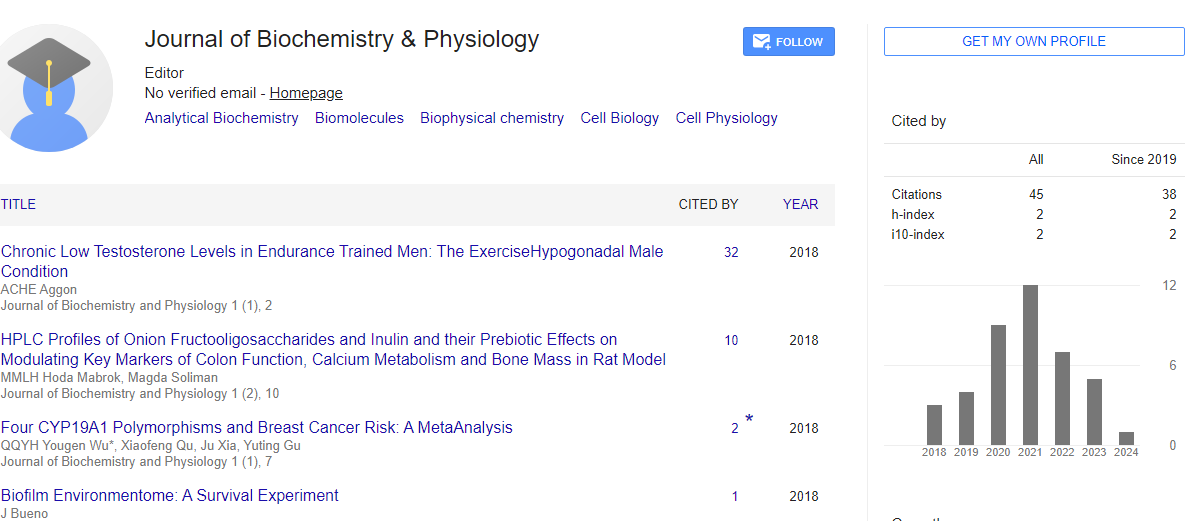Perspective, J Biochem Physiol Vol: 6 Issue: 2
Bioorganic Catalysts and Their Natural Catalyzing Power
Rong Mender*
1Department of Chemistry, Shiraz University, Shiraz, Iran
*Corresponding Author: Rong Mender,
Department of Chemistry, Shiraz
University, Shiraz, Iran
E-mail: mendere@susc.ac.ir
Received date: 29 May, 2023, Manuscript No. JBPY-23-110487;
Editor assigned date: 31 May, 2023, PreQC No. JBPY-23-110487(PQ);
Reviewed date: 14 June, 2023, QC No. JBPY-23-110487;
Revised date: 21 June, 2023, 2023, Manuscript No. JBPY-23-110487(R);
Published date: 28 June, 2023 DOI: 10.4172/jbpy.1000137.
Citation: Mender R (2023) Bioorganic Catalysts and Their Natural Catalyzing Power. J Biochem Physiol 6:2.
Abstract
Bioorganic catalysts, often referred to as enzymes, are remarkable biocatalysts that accelerate chemical reactions with unparalleled efficiency and specificity. These biologically derived catalysts have fascinated researchers for decades, inspiring admiration for their efficiency, specificity, and elegance in driving a diverse array of biochemical processes essential for life.
Description
Bioorganic catalysts, often referred to as enzymes, are remarkable biocatalysts that accelerate chemical reactions with unparalleled efficiency and specificity. These biologically derived catalysts have fascinated researchers for decades, inspiring admiration for their efficiency, specificity, and elegance in driving a diverse array of biochemical processes essential for life.
Enzymes are the cornerstone of biochemical transformations within living organisms, serving as the architects that accelerate chemical reactions that would otherwise occur at an impractically slow rate under physiological conditions. What sets enzymes apart is their unparalleled precision in promoting reactions without being consumed in the process, enabling them to serve repeatedly as molecular facilitators. Their catalytic proficiency often exceeds that of synthetic counterparts, making them ideal models for the development of green and sustainable industrial processes.
The natural catalyzing power of enzymes is rooted in their intricate three-dimensional structures, which are exquisitely tailored to accommodate specific substrates the molecules upon which enzymes act. This structural specificity ensures that enzymes recognize and bind their substrates with remarkable fidelity, minimizing wasteful side reactions and enhancing reaction efficiency. Moreover, enzymes often create a microenvironment within their active sites, fine-tuning conditions such as pH, temperature, and ionic strength to further enhance catalytic performance. The astounding diversity of enzymatic functions spans a spectrum of biochemical reactions, ranging from breaking down complex molecules into simpler forms during digestion to facilitating the synthesis of intricate macromolecules like DNA and proteins. Enzymes are involved in nearly every facet of cellular function, from energy production to cellular signaling, showcasing their pivotal roles in maintaining cellular harmony.
Bioorganic catalysts represent nature's answer to the challenges of chemical transformations, offering precise and controlled catalysis. The intricate mechanisms behind the catalytic prowess of enzymes and their role in intercellular communication.
Catalytic mechanisms of bioorganic catalysts
Active sites: Enzymes possess specific active sites where substrates bind and reactions occur.
Lock-and-key vs induced fit: Enzyme-substrate interactions can follow a lock-and-key or induced fit model, ensuring specificity.
Catalysis strategies: Enzymes employ various strategies, including acid-base catalysis, covalent catalysis, and metal ion catalysis.
Structural diversity of bioorganic catalysts
Protein folding: Enzymes adopt specific three-dimensional structures that dictate their catalytic activities.
Cofactors and coenzymes: Non-protein components like metal ions and coenzymes assist in catalysis
Multimeric complexes: Some enzymes consist of multiple subunits that enhance catalytic efficiency.
Enzymatic catalysis in biotechnology and industry
Enzymes in food and beverages: Amylases, proteases, and lipases play crucial roles in food processing and production.
Bioremediation: Enzymes participate in the degradation of pollutants and environmental cleanup.
Pharmaceuticals and biofuels: Enzymes are used in drug synthesis, bio catalytic reactions, and biofuel production.
Enzyme engineering and design
Rational engineering: Modifying enzymes for enhanced activity, specificity, or stability.
Directed evolution: Mimicking natural evolution in the laboratory to create novel enzymes.
Synthetic biology: Designing new enzyme functions and pathways for biotechnological applications.
Intercellular communication through enzymes
Enzymes as signaling molecules: Some enzymes, such as kinases and phosphatases, relay signals within cells.
Metabolic pathways: Enzymes participate in interconnected biochemical pathways, influencing cellular responses.
Enzyme-based cell-to-cell communication: Enzymes like cytokines mediate communication between immune cells.
Bioorganic catalysts and disease
Enzyme deficiencies: Mutations or deficiencies in enzymes can lead to metabolic disorders.
Enzymes as drug targets: Inhibiting or activating enzymes is a common strategy in drug development.
Challenges and future directions
Enzyme stability and engineering: Developing robust enzymes for industrial applications remains a challenge.
Systems-level understanding: Integrating enzyme activities into broader cellular networks is complex.
Conclusion
Bioorganic catalysts exemplify the elegance of nature's chemistry, offering inspiration for both basic research and practical applications. Their catalytic power, structural diversity, and role in intercellular communication underscore their importance in shaping the biochemical landscape of living organisms. This delves into the fascinating world of bioorganic catalysts, exploring their catalytic mechanisms, structural features, and diverse applications in biotechnology and industrial processes. It also discusses how these catalysts contribute to intercellular communication and biochemical pathways within living organisms.
 Spanish
Spanish  Chinese
Chinese  Russian
Russian  German
German  French
French  Japanese
Japanese  Portuguese
Portuguese  Hindi
Hindi 